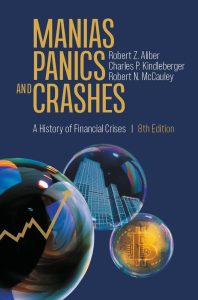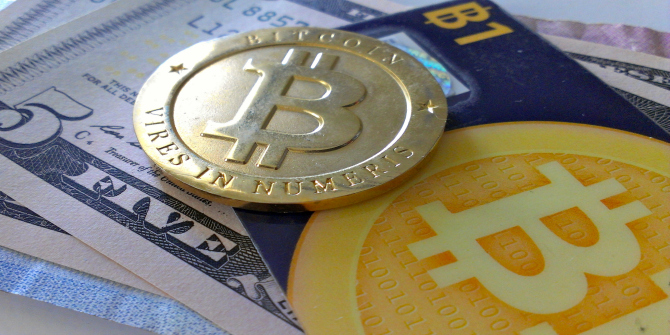In 1978 Charles Kindleberger published what was to become the classic text on financial bubbles, Manias, Panics, and Crashes: A History of Financial Crises. Though Kindleberger died in 2003, his work has never seemed more relevant. Economists have described recent economic conditions as the “Everything Bubble,” where the prices of all asset classes are simultaneously overvalued.
This year sees the publication of a new 8th edition of the text co-authored by Robert McCauley, an economist who has held senior positions at the Federal Reserve and Bank for International Settlements (BIS). Martin Walker, Director of Banking and Finance at the Center for Evidence-Based Management, spoke to him about the new edition and whether understanding of financial crises has improved.
 Q: Why was a new edition of this classic necessary?
Q: Why was a new edition of this classic necessary?
The main reason was the evolution of the Federal Reserve (the Fed) as an international lender of last resort [lending to banks that would otherwise go bankrupt] in 2008 [in response to the financial crash], and again in 2020 [in response to the COVID-19 pandemic], when the Fed provided unlimited dollar funding to major central banks. The Fed also extended its role as “buyer of last resort” from commercial paper [short-term] in 2008 to corporate bonds [long-term] in 2020.
Q: The book tells of a seemingly endless cycle of greed and stupidity. Are economists getting any better at spotting bubbles?
Generally not.
There is no place in standard economic reasoning for manias. Ben Bernanke discounted Kindleberger’s views as depending on human irrationality, but Kindleberger made it very clear that individual rationality can lead to collectively irrational results.
Too often, economists put their efforts into explaining the “rationality” of high asset prices. Irving Fisher made a famously bad call on the “permanently high plateau” of equity prices just before Wall Street crashed in 1929.
Still, some economists have successfully identified bubbles. In the 1978 edition, Kindleberger correctly called the international lending mania years before Mexico’s and Brazil’s near-default in 1982. Kazuo Ueda at the University of Tokyo spotted the Japanese equity and property bubbles of the late 1980s. Robert Schiller called bubbles in the late 1990s and mid-2000s, and Robert Aliber, the author of the 5th, 6th and 7th editions of Manias, Panics, and Crashes, called the US housing and Iceland bubbles in 2004-06.
Perhaps it is easier to see a bubble if one is socially distant from others – like the doctor in Ibsen’s Enemy of the People – or even physically distant.
There is no place in standard economic reasoning for manias.
Q: One of the main responses to the 2008 Financial Crisis was a demand for greater transparency in financial markets. In the UK’sliability-driven investment (LDI) crisis of September 2022, public bodies knew who owned gilts (British government bonds) and who were counterparties to derivatives and Repurchase Agreements (repos). Yet no one put this together to predict what might happen in response to something like the Truss mini budget. Is transparency really the answer?
Do not expect too much from transparency.
Recently in the United States, quarterly report footnotes showed the value of all bond holdings of listed banks, but market participants ignored them. For their part, the authorities based stress tests on a credit collapse, as in 2008. Before that, the most stringent stress test was based on events in 1994, when there was a rapid rise of interest rates but no recession. Stress tests and financial stability reports are of little use if central bankers do not cultivate an imagination for disaster.
Stress tests and financial stability reports are of little use if central bankers do not cultivate an imagination for disaster.
Q: Do central banks need more people with imagination?
Absolutely, but probably the best that can be done is to train economists how to talk to people in the market [such as bankers and traders].
In the early 1980s, I learned how to do it at the New York Fed without even realising what I was doing. When I joined the BIS, I made a practice of visiting London and, like an anthropologist, talking to the natives in the City about what they were doing.
The practice of economists talking to market participants atrophied at the New York Fed before the 2008 crisis and at the Bank of England as well.
Probably the best that can be done is to train economists how to talk to people in the market.
Q: Has the wave of financial innovation that started in the late 1980s, with the growth of derivatives and structured finance increased financial instability?
Hy Minsky taught us that during good times, market participants find new means of funding themselves that make the system less stable.
I would back up the timeline to include things like the invention of certificates of deposits (CDs) and the birth of the Eurodollar. In the upswing firms and banks find new ways of funding themselves from repos, to CDs, to Eurodollars, and to commercial paper. Market participants invent “near monies” [forms of financial assets that have similar characteristics to central bank reserves or commercial bank deposits but have differences in legal status and acceptability] that are innately risky. Money Market Funds, for instance, are essentially banks without capital [that is, they take deposits and lend out funds by buying financial instruments, but lack the capital to absorb losses if borrowers default].
When the crunch comes, the Fed finds it necessary to sustain more and more forms of near money. In 2008 and 2020, the Treasury and Fed came to the rescue of money market funds holding commercial paper and Eurodollars. In 2020, the Fed bought corporate bond exchange-traded funds, and even junk bond [high-yield bonds with low credit quality] funds.
Q: You identify how the Fed became global lender of last resort through its extension of unlimited swaps to major central banks. Does this undermine the argument that the US dollar is in decline? In 2008, the US was the epicentre of a great financial crisis, but the dollar rose in value. Is the dollar more powerful than it is given credit for?
Eswar Prasad was on to something in his book The Dollar Trap: in some ways the dollar emerged stronger from the 2008 crisis.
The dollar went up in late 2008 because European banks were running huge balanced books [assets] in dollars, but when their assets crumbled, suddenly they were short dollars. Behind the credit risk of dodgy mortgage securities lurked currency risk. Since the capital of the banks was in euros, or sterling or Swiss francs, the banks needed to buy dollars as they wrote down the value of their dollar-denominated securities. Some have suggested that it is an exorbitant privilege that the US benefits from a demand for its currency and its government debt when its financial system is imploding. In any case, when the Fed opened the dollar spigots to major central banks in 2008 and 2020, it powerfully reinforced the role of the dollar.
The risk is not that the rest of the world is “de-dollarising,” rather it is that the rest of the world continues to use the dollar but politics prevents the Fed from backstopping that use. Nowadays even US strategic rivals depend on the dollar.
In some ways the dollar emerged stronger from the 2008 crisis.
Q: The People’s Bank of China has provided Renminbi swap lines to dozens of countries. Is this an attempt to compete with the Fed rather than increase the use of the Renminbi?
Perhaps both.
In the recent case of Argentina, it looks like dollar swaps were in play. Patrick Foulis in the Economist in 2015 envisioned a world in which all the dollar users that do not enjoy access to the Fed might pool their dollar resources. Something like this was emerging with the currently suspended BRICS swaps. However, the predominance of China in that grouping means that such multilateralism would be a fig leaf on a China-centred arrangement.
Paul Tucker in Global Discord envisions superpower rivalry taking the form of competitive swap networks. He argues that far-sighted financial diplomats would recognise that the Fed cannot sustain excluding the Reserve Bank of India from its swap lines even as India is courted as a friendly shore for assembling Apple phones and is included in Indo-Pacific naval exercises. But note that the Fed’s repo facility for central banks is available for all holders of US Treasuries.
Q: A new addition to Manias, Panics and Crashes is a chapter on the crypto bubble. Has the crypto bubble been unique in having practically no effect in stimulating productive investment?
Unusual but not unique.
Crypto is basically just a “pump and dump” [when market players artificially drive up the price of an asset with the intention to sell their holdings when the price is high] and could have gone in the swindles chapter of Manias, Panics, and Crashes with Bernie Madoff. But a separate chapter did provide a place for the supreme irony that crypto, originally sold as trustless and institution-free, is foundering precisely on the abuse of trust by the institutions on which the crypto mania came to depend, whether Coinbase, Binance or Tether.
The supreme irony that crypto […] is foundering precisely on the abuse of trust by the institutions on which the crypto mania came to depend.
To your question, in Dodging Bullets: Changing Corporate Capital Structures in the 1980s and 1990s, two New York Fed colleagues and I analysed the corporate leveraging mania featuring junk bonds, the predecessor for today’s excesses in private equity. The cover story was to leverage up firms to prevent their wasting free cash on low-return investments. In today’s world, some might favour a giant leveraged buyout of Chevron to force it to pay out cash rather than re-investing in world-warming oil production. In any case, the mania associated with Mike Milken was unusually anti-investment.
Thus, crypto is not unique. But it is unusual in that, contrary to the Kindleberger model, it did not boost investment. This characteristic, and the limited links of crypto to the fiat financial system, mean there is little to lose from crypto going to zero.
Note: This interview gives the views of the authors, and not the position of the LSE Review of Books blog, or of the London School of Economics and Political Science. The interview was conducted by Martin Walker for LSE Review of Books.
Main image credit: vicznutz on Pixabay.








9 Comments